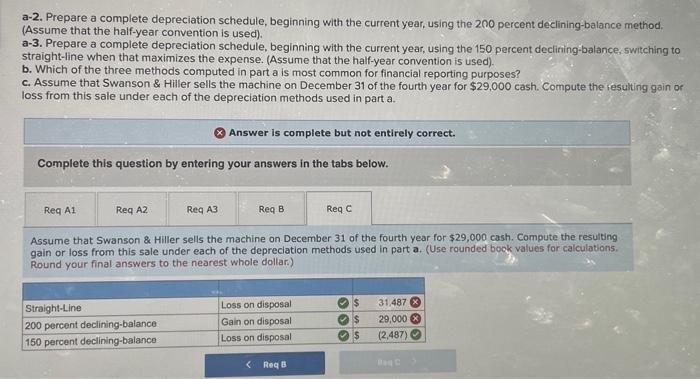a-2. Prepare a complete depreciation schedule, beginning with the current year, using the 200 percent declining-balance method. (Assume that the half-year convention is used). a-3. Prepare a complete depreciation schedule, beginning with the current year, using the 150 percent decliting-balance, switching to straight-line when that maximizes the expense. (Assume that the half-year convention is used). b. Which of the three methods computed in part a is most common for financial reporting purposes? c. Assume that Swanson \& Hiller sells the machine on December 31 of the fourth year for $29,000 cash. Compute the resulting gain or loss from this sale under each of the depreciation methods used in part a. * Answer is complete but not entirely correct. Complete this question by entering your answers in the tabs below. Assume that Swanson \& Hiller sells the machine on December 31 of the fourth year for $29,000 cash. Compute the resulting gain or loss from this sale under each of the depreciation methods used in part a. (Use rounded book values for calculations. Round your final answers to the nearest whole dollar.) a-2. Prepare a complete depreciation schedule, beginning with the current year, using the 200 percent declining-balance method. (Assume that the half-year convention is used). a-3. Prepare a complete depreciation schedule, beginning with the current year, using the 150 percent decliting-balance, switching to straight-line when that maximizes the expense. (Assume that the half-year convention is used). b. Which of the three methods computed in part a is most common for financial reporting purposes? c. Assume that Swanson \& Hiller sells the machine on December 31 of the fourth year for $29,000 cash. Compute the resulting gain or loss from this sale under each of the depreciation methods used in part a. * Answer is complete but not entirely correct. Complete this question by entering your answers in the tabs below. Assume that Swanson \& Hiller sells the machine on December 31 of the fourth year for $29,000 cash. Compute the resulting gain or loss from this sale under each of the depreciation methods used in part a. (Use rounded book values for calculations. Round your final answers to the nearest whole dollar.)







